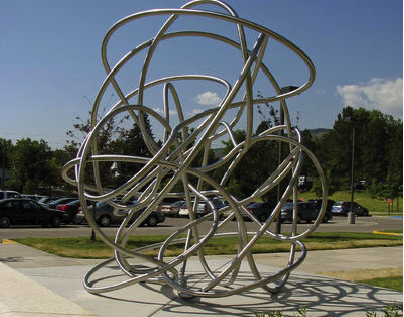Gordian Knot
Problem solving for modern engineers tends to require a large amount of time and energy spent on considering how to best approach the problem. This tangled up web of logic can appear as a knot without end. An ancient problem in this vein is the Gordian Knot. In 333 B.C. it was said that Alexander the Great reached the capital city of Phrygia, now part of modern-day Turkey. There he found in the center of the town a chariot tied to a post. The chariot belonged the city’s founder, and it had been foretold that whoever untied the knot was destined to unite all of Asia. After spending several days trying to untangle the knot by some mechanical means, Alexander the Great realized that he could instead cut through the knot to achieve the same effect. Since then the phrase ‘to cut through the Gordian Knot’ has meant to solve a complex problem with unexpected means. To inspire students to realize the value of this type of innovative thinking 300 feet of stainless-steel pipe was turned into a knot without beginning or end by Douglas Kornfeld in 2008. The sculpture, dubbed Gordian Knot, now resides just outside of the Center for Technology and Learning Media (CTLM).
From the Warnings of Daedalus: A Flight Imagined
Just inside CTLM, another art piece adorns the second floor atrium which has been there since the building’s grand opening in the August of 2001. On first glance, the only thing that stands out about the piece are the prominent shades of blue. There are similarities to the works of MC Escher, who is famous for creating drawings that had elements of the foreground spatially clash with elements of the background. There is nothing more to notice about the painting from the second floor balcony, but in the first floor lounge dedicated to Clare Taylor there is a small, unassuming plaque that suggests the title of the painting is From the Warnings of Daedalus: A Flight Imagined. Since there is nothing in the painting depicting the famous myth many onlookers would likely be left thinking, ‘it’s Greek to me’ and, oddly enough, they would be on the right track. The piece was created in 2001 by Kate Leonard to satisfy the Art in Public Places program requirements of CTLM’s construction.
Daedalus was the famed Greek inventor most commonly known for building the labyrinth that contained the minotaur in Crete. In an attempt to escape from the island with his son Daedalus fashioned two wings out of wax and bird feathers. These wings worked to help him escape Crete, but his son who didn’t head his advice flew too close to the sun and his pair of wings melted. The art is broken into three panels each with a specific meaning. According to Leonard, as she was quoted in an article from Mines Magazine printed in their fall 2001 issue, “The artwork addresses three main topics: the connections between nature and scientific inspiration”. This is reflected in the panel depicting Nautilus Shell which has long served as inspiration in geometry and math. The second and third themes of the painting are “the relationship between pure and applied sciences, and the consequences of the values we embody as manifested on the landscape.” Thought these are less clearly divided between the remaining two panels, these two themes shed light on the meaning of the two panels left. This last theme is reminiscent of Daedalus, as for his freedom Daedalus lost his only son. Reminding us that we need to be conscious of the possible ramifications of future technology. The two pieces of art inspired by Greek mythology on display at CTLM are powerful reminders of the value of new approaches to old problems and also the dangers of what we create.



'Public Art Series : CTLM' has no comments
Be the first to comment this post!